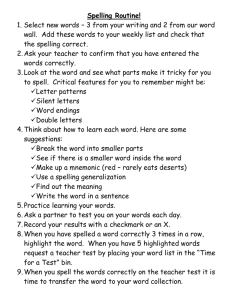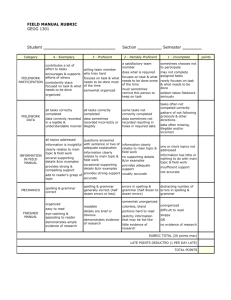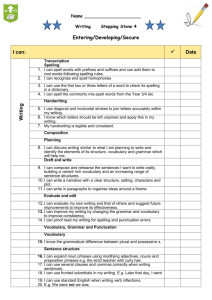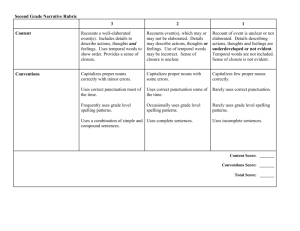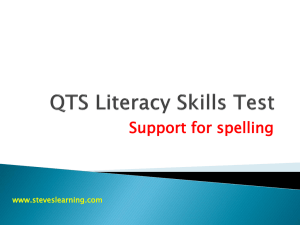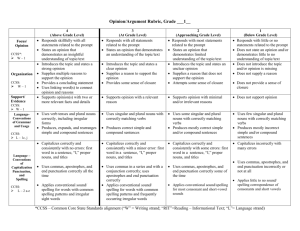K-HS Conventions Continuum
advertisement
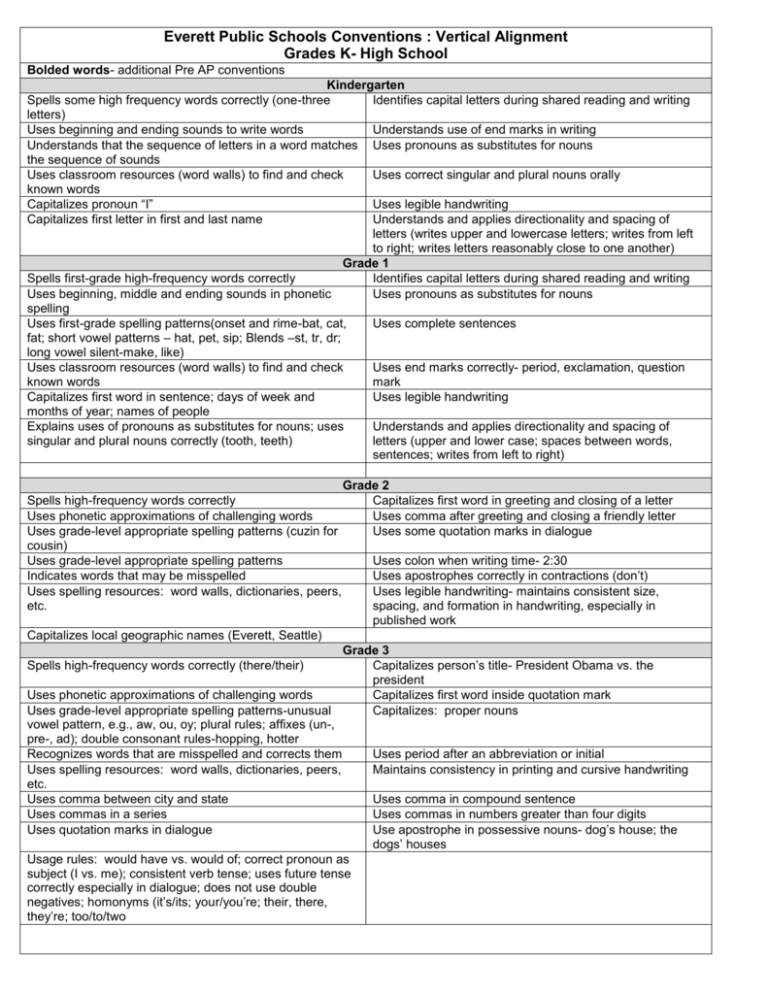
Everett Public Schools Conventions : Vertical Alignment Grades K- High School Bolded words- additional Pre AP conventions Kindergarten Spells some high frequency words correctly (one-three Identifies capital letters during shared reading and writing letters) Uses beginning and ending sounds to write words Understands use of end marks in writing Understands that the sequence of letters in a word matches Uses pronouns as substitutes for nouns the sequence of sounds Uses classroom resources (word walls) to find and check Uses correct singular and plural nouns orally known words Capitalizes pronoun “I” Uses legible handwriting Capitalizes first letter in first and last name Understands and applies directionality and spacing of letters (writes upper and lowercase letters; writes from left to right; writes letters reasonably close to one another) Grade 1 Spells first-grade high-frequency words correctly Identifies capital letters during shared reading and writing Uses beginning, middle and ending sounds in phonetic Uses pronouns as substitutes for nouns spelling Uses first-grade spelling patterns(onset and rime-bat, cat, Uses complete sentences fat; short vowel patterns – hat, pet, sip; Blends –st, tr, dr; long vowel silent-make, like) Uses classroom resources (word walls) to find and check Uses end marks correctly- period, exclamation, question known words mark Capitalizes first word in sentence; days of week and Uses legible handwriting months of year; names of people Explains uses of pronouns as substitutes for nouns; uses Understands and applies directionality and spacing of singular and plural nouns correctly (tooth, teeth) letters (upper and lower case; spaces between words, sentences; writes from left to right) Spells high-frequency words correctly Uses phonetic approximations of challenging words Uses grade-level appropriate spelling patterns (cuzin for cousin) Uses grade-level appropriate spelling patterns Indicates words that may be misspelled Uses spelling resources: word walls, dictionaries, peers, etc. Grade 2 Capitalizes first word in greeting and closing of a letter Uses comma after greeting and closing a friendly letter Uses some quotation marks in dialogue Uses colon when writing time- 2:30 Uses apostrophes correctly in contractions (don’t) Uses legible handwriting- maintains consistent size, spacing, and formation in handwriting, especially in published work Capitalizes local geographic names (Everett, Seattle) Grade 3 Capitalizes person’s title- President Obama vs. the president Uses phonetic approximations of challenging words Capitalizes first word inside quotation mark Uses grade-level appropriate spelling patterns-unusual Capitalizes: proper nouns vowel pattern, e.g., aw, ou, oy; plural rules; affixes (un-, pre-, ad); double consonant rules-hopping, hotter Recognizes words that are misspelled and corrects them Uses period after an abbreviation or initial Uses spelling resources: word walls, dictionaries, peers, Maintains consistency in printing and cursive handwriting etc. Uses comma between city and state Uses comma in compound sentence Uses commas in a series Uses commas in numbers greater than four digits Uses quotation marks in dialogue Use apostrophe in possessive nouns- dog’s house; the dogs’ houses Usage rules: would have vs. would of; correct pronoun as subject (I vs. me); consistent verb tense; uses future tense correctly especially in dialogue; does not use double negatives; homonyms (it’s/its; your/you’re; their, there, they’re; too/to/two Spells high-frequency words correctly (there/their) Grade 4 Single/plural agreement between nouns and modifiers Correct placement of pronouns Among (more than two) vs. between (two) Uses conjunctions logically Uses prepositions correctly Uses collective nouns Does not use comma splices Grade 5 Ellipsis correctly (to show omitted words, to show pause) Comma after date or address within text Self corrects spelling errors Commas to set off interjections or explanatory phrases Quotation marks in dialogue correctly Hyphen to join numbers Develops a personal spelling list Hyphen in numbers Develops a personal spelling list Capitalizes important words in a title of book or article Capitalizes abbreviations correctly Comma to set off titles or initials Comma after an introductory phrase Italics, underlining, or quotation marks for titles Colon after greeting in a business letter Capitalizes brand names Capitalizes geographic regions Periods in abbreviations Semicolon between two independent clauses Subject vs. object pronouns correctly Grade 6 Apostrophe to show quotation within a quotation in dialogue Maintains a consistent person Appositive Phrases Multiple strategies to spell Capitalizes languages, races, nationalities, and religions Paragraph conventions Parallel construction when listing verbs particularly in Comma informational and technical writing Commas in appositives Parentheses correctly Parts of Speech Commas to set off direct address Detailed labeling, captions, headings, and subheadings Prepositional Phrase Distinguish between dependent and independent clauses Semi-Colon Semicolon correctly between two independent clauses Fragments in dialogue as appropriate connected by a conjunctive adverb Infinitive Phrases Sentence Combining Introduction to advanced syntax techniques like anaphora and repetition Shows agreement of pronoun and its referent Know and use four basic sentence types Grade 7 Experiment with reverse sentence order Adverbs vs. adjectives correctly Bullets in technical writing Hyphen to prevent confusion Capitals correctly in outline or list Parallel to construction of elements in a list Relationships between verbs, objects and complements Commas to separate an interrupter Comparative and superlative adjectives Semicolons to separate groups that contain commas Consistent capitalization when formatting technical documents Use of stanzas and other textual markers Creative manipulation of independent and dependent clauses Use of quotations Grade 8 Adverbial clauses Dash Apostrophes to form plurals of letters or numbers Diagonal slash Asyndeton Fewer vs. less Capitalizes titles of a specific course Parallel construction when listing infinitive phrases Colon Parallelism Participial phrases Colon between title and subtitle Polysyndeton Commas and periods inside quotation marks Commas to enclose titles Grade 9/10 Active voice except when passive voice is appropriate Either or and neither nor Dash to indicate emphasis or sudden break, to set off an Appropriate punctuation when writing in other languages introductory series, or to show interrupted speech Avoids dangling modifiers Parallel construction in clauses Brackets around an editorial correction or to set of added words That vs. which and that vs. who Commas to set off nonrestrictive clauses Who vs. whom Commonly confused words correctly Teacher Resources for gaining knowledge about conventions: Websites for Grammar http://learning.blogs.nytimes.com/2010/03/04/5-easy-ways-to-learn-grammar-with-the-new-york-times/ http://www.chompchomp.com/rules.htm http://theteacherscafe.com/Teacher-Directory/Grammar-lesson-Plans.htm http://grammar.quickanddirtytips.com/default.aspx http://www.englishgrammar.org/ http://lessons.englishgrammar101.com/EnglishGrammar101/Foreword.aspx http://www.grammarbook.com/english_rules.asp http://owl.english.purdue.edu/owl/section/1/5/ http://grammar.ccc.commnet.edu/grammar/ http://www.edufind.com/english/grammar/grammar_topics.php http://www.englishgrammar.org/ http://www.webenglishteacher.com/grammar.html http://www.curriculumbits.com/proddetail.php?prod=eng0008 http://grammar.ccc.commnet.edu/GRAMMAR/marks/semicolon.htm
